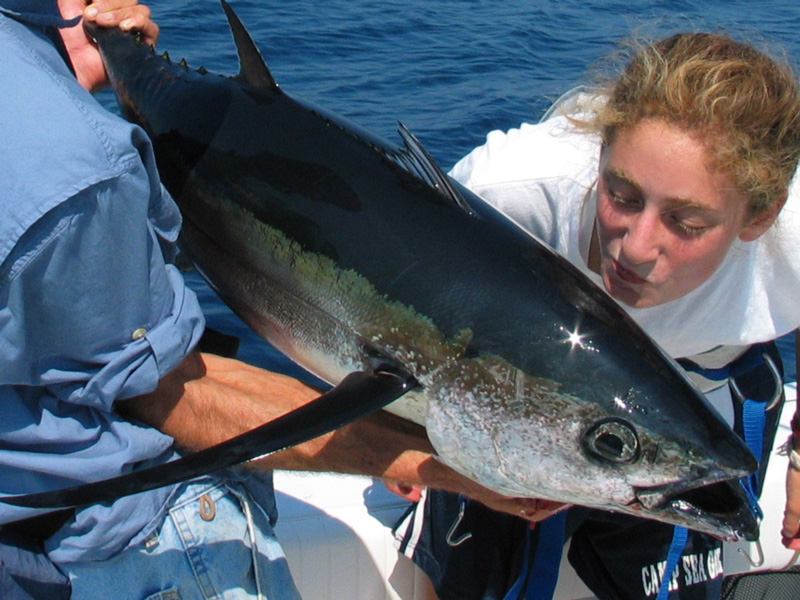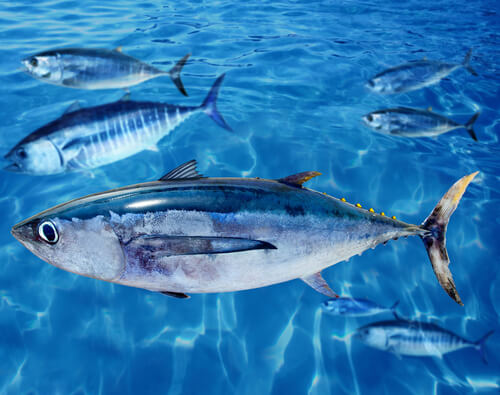The albacore (Thunnus alalunga), known also as the longfin tuna, is a species of tuna of the order Perciformes. It is found in temperate and tropical waters across the globe in the epipelagic and mesopelagic zones. There are six distinct stocks known globally in the Atlantic, Pacific, and Indian oceans, as well as the Mediterranean Sea. The albacore has an elongate, fusiform body with a conical snout, large eyes, and remarkably long pectoral fins. Its body is a deep blue dorsally and shades of silvery-white ventrally. Individuals can reach up to 1.4 m (4 ft 7 in) in length.
Albacore is a pelagic predator that eats a wide variety of foods, including but not limited to fish, crustaceans, and cephalopods. They are unique among most tuna in that their primary food source is cephalopods, with fish making up a much smaller portion of their diet. Reproduction usually occurs from November to February and is oviparous. An adult female can release over two million eggs in a single cycle. Fry (juvenile fish) generally stay near where they were spawned for about a year before moving on. Albacore form schools based on their stage in the life cycle, but also combine with other tuna-like the skipjack tuna, yellowfin tuna, and bluefin tuna. Once grown, schools are highly migratory.
The albacore is a very economically important fish and is a target of commercial and recreational fisheries. It was originally the basis for the United States tuna-canning industry and is no less important today, making up significant percentages of the gross domestic products of various Pacific nations. It was listed as Near Threatened by the International Union for Conservation of Nature (IUCN) because of the threat of overfishing but is now Least Concern again. Several stocks were in significant decline and the species’ overall population were decreasing but are now recovering thanks to the enforcement of regional fishing quotas.
Distribution and habitat

The albacore has a cosmopolitan distribution in tropical and temperate waters across the globe and every ocean as well as the Mediterranean Sea.
Its latitudinal range extends from 59°N to 46°S. Its temperature range is 10–25 °C (50–77 °F). Its depth range is 0–600 m (0–1,969 ft; 0–328 fathoms) in the epipelagic and mesopelagic zones. It is most often found in surface waters 15.6–19.4 °C (60.1–66.9 °F) in temperature, though larger individuals can be found in deeper waters 13.5–25.2 °C (56.3–77.4 °F). It can survive at temperatures as low as 9.5 °C (49.1 °F) for short periods. It favors areas where warm and cool water mix.
Migration
A highly migratory species, schools of albacore travel great distances, though Atlantic and Pacific populations do not appear to mix. North Pacific albacore migrate to two regions of the Northeast Pacific: one off the northern part of Baja California, Mexico, and the other off the coasts of Washington and Oregon. Every summer, North Atlantic albacore head to the Bay of Biscay off of France and Spain, but now arrive about 8 days earlier than they did 40 years ago.
Since the 1970s the NOAA Fisheries, Southwest Fisheries Science Center (SWFSC) has collaborated with American Fishermen’s Research Foundation (AFRF) in tagging studies of albacore in the North Pacific. Through these studies we have learned that juvenile albacore (to 2 years of age) make trans-Pacific migrations in their younger years between Japan and the West coast of North America. To date over 24,000 albacore have been tagged with conventional dart tags and 1,245 of these have been recovered. In Spring of 2001 AFRF and the SWFSC began a pilot project to learn more about the migration habits of North Pacific albacore, Thunnus alalunga to allow the incorporation of detailed migration movements into stock assessment models. Archival tags are a recent technical innovation that are being used to collect daily locations (through light level data recorded by the tag), internal temperature of the fish’s abdomen, ambient water temperature, and depth. Genetic research using ddRAD sequencing indicates that albacore migrate between the North and South Pacific oceans across the equator.
Human interaction
Commercial fishery
Albacore is a prized food, and the albacore fishery is economically significant. Methods of fishing include pole and line, long-line fishing, trolling, and some purse seining.
The harvest of albacore tuna for commercial use began at the start of the 20th century. The migratory patterns of the fish brought droves of albacore schools near the coastline of southern California, which sparked the start of commercial albacore fishing. In 1903, 700 cases of albacore were used as an experimental pack which ultimately led to the development of the U.S. tuna-canning industry. The experiment was a huge success, and the commercial fishery expanded rapidly due to the high level of demand for canned tuna. By the 1920s, the industry expanded further and three other species of tuna, bluefin, yellowfin, and skipjack, were also being canned. Albacore tuna is the only species that can be marketed as “white meat tuna”. The canning industry uses this label as a way to differentiate canned albacore from other types of tuna.
From 2010 to 2013, a study by Oceana, an ocean preservation organization, tested over 114 samples of tuna, and found that 84% of the white tuna samples were escolar.
Many Pacific island countries and territories (PICTs) heavily rely on oceanic fisheries for economic development and food security. The albacore is one of the main four species of tuna that support oceanic fisheries along with the skipjack, yellowfin, and the bigeye tunas. Domestic tuna fleets and local fish processing operations contribute from 3-20% of the gross domestic product in four PICTs. License fees from foreign ships provide an average of 3-40% of government revenue for seven different PICTs. Processing facilities and tuna fishing vessels provide more than 12,000 jobs for workers in the Pacific islands. Fish provide 50-90% of dietary animal protein in rural areas of PICTs.
Recreational fishery
Albacore are sought after by sport fishers. Since 2000, a large recreational fishery for albacore has been established in Oregon, Washington and California. The fisheries in Oregon and Washington are supported by seasonal warm water influxes from the California Current with the season lasting from mid-July until October.
